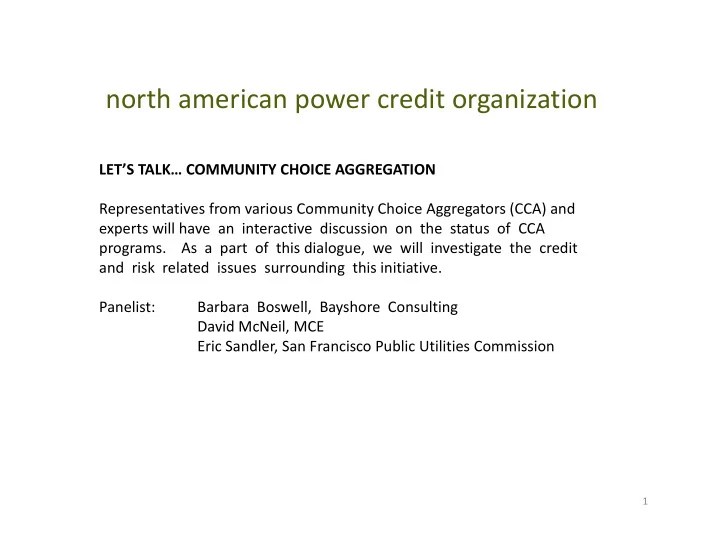

north american power credit organization LET’S TALK… COMMUNITY CHOICE AGGREGATION Representatives from various Community Choice Aggregators (CCA) and experts will have an interactive discussion on the status of CCA programs. As a part of this dialogue, we will investigate the credit and risk related issues surrounding this initiative. Panelist: Barbara Boswell, Bayshore Consulting David McNeil, MCE Eric Sandler, San Francisco Public Utilities Commission 1
CCAs Created by the Legislature • 2000 Energy Crisis prompted interest in greater transparency and local control • AB 117 (2002, Migden): Enabled energy choice through local government‐based entities • SB 790 (2011, Leno): Established a CCA ‘bill of rights’ and allowed CCAs to administer efficiency programs 2
How Community Choice Works 3
Statewide CCA Developments 4
Operating Programs Overview Annual Annual Load Peak Minimum Uses Load Projected Customer Load RPS Unbundled 2016 2017 CalCCA Members Accounts MW (2017) RECs? GWh GWh Apple Valley Clean Energy 8% n/a 235* 29,000 70 35% CleanPowerSF 73,000* 93* 35% None 220 520 Lancaster Choice Energy 52,000 132 35% 8% 590 595 MCE 255,000 520 55% 0 ‐ 3% 2,102 2,743 Peninsula Clean Energy 300,000 660 50% None n/a 3,800 2,600* n/a Silicon Valley Clean Energy 243,000 688 50% None 730* Redwood Coast Energy n/a Authority 60,000 138 37% None Sonoma Clean Power 235,000 512 43% None 2,330 2,550 CalCCA Member Totals 1,247,000 2,642 43% (avg) 2% (avg) 5,242 10,208 *Represents a partial year due to enrollment process 5
Snapshot of CCA Portfolios in 2016 ( forecast 2017 for new programs, estimated May 2017 ) 100% 13% 14% 17% 90% 23% 24% 25% 36% 12% 80% 50% 24% 70% 65% 65% 44% 22% 25% 60% 36% 41% 27% 50% 23% 40% 6% 6% 9% 30% 53% 50% 50% 5% 20% 40% 37% 36% 35% 35% 30% 22% 10% * 0% * *Pacific Gas & Electric and Southern California Edison are Investor‐Owned Utilities included 6 Renewable Large Hydro Nuclear Coal Natural Gas Unspecified for comparison
CCA Business Models • Joint Powers Authority – MCE – Sonoma Clean Energy • Enterprise Model / Single Jurisdiction – SFPUC – Lancaster Choice • Hybrid Model – Community Choice Energy Authority 7
CCA Risk Fundamentals • 7 year track record of success • Stable customer base: Opt‐in program • Rate setting, budget and contracting autonomy • Limited / No support from local governments • Focus on managing risk and building reserves • Strength in numbers; – CCAs expected to serve over 80% of eligible California communities by 2022 – CalCCA trade association formed to represent CCAs in the regulatory and legislative arenas – Increasing cooperation between CCAs on operational matters 8
��������������������� ��������� ���������������� ���������� ��� ���������������� ����������������������� ������������������ �������������������������� ������������������� ������������ ����������������� ���������������������� �������������������� ��������������������������� ������������� ���������������������������� �������������������������������������������� �������������������������������������������
�������������� ���������� ��� ���������� ���������� ������������ � ���� ������������ ������������ ������� � ���� ������������ ������������ ������� ������������� ������ ������������ ������������ ��������� ���� ���� ��������� ����������� �������� ������ ������������ ������������ ������� ��������������� ���� ��������� ����������� ����� ���������� �������� �������� ���� ���������������
CleanPowerSF NAPCO Credit Conference Eric Sandler, CFO San Francisco Public Utilities Commission September 18, 2017
San Francisco Public Utilities Commission—SFPUC • Department of City & County of San Francisco • Governed by appointed five-member Commission • $1.1 billion operating budget • $8.0 billion 10-year capital plan • 2,300 + employees • Three separate enterprise funds • Water— retail/wholesale water service to service area population of 2.6 million, ratings AA-/AA-, $4.3 billion outstanding debt • Wastewater —wastewater collection and treatment to service area population of 850,000, ratings AA/AA-, $950 million outstanding debt • Power —retail electricity service City’s municipal buildings/operations, wholesale electricity to MID/TID/WSPP, public utility ratings AA-/A+, $39 million outstanding debt • CleanPowerSF operated as financially independent component of Power Enterprise 2
CleanPowerSF Goals and Objectives Lead with Affordable and Reliable Service Balanced Program Design Provide Cleaner Electricity Allows Alternatives Delivery Across Competing Objectives Invest in Local Renewable While Projects and Local Jobs Providing Financial Stability While Providing for Long-Term Rate and Financial Stability 3
CleanPowerSF Launch Strategy • Long-term goal of independent credit rating • Established CleanPowerSF as separate sub-fund within Power Enterprise • Segregated revenues/expenses/assets/liabilities • Auto-appropriated fund for supplier payments • Quarterly financial statements • Commission adopted financial policies for rate setting and reserves • Operating and rate stabilization reserves • Specific Power Enterprise support • $8 million working capital loan • Super-subordinate net-revenue pledge to support LOC for collateral posting for power contracts 4
CleanPowerSF Launch • Launched in May 2016 • Phase I—76,000 residential & commercial customer accts • ~ 20% of projected customer base • 60MW average size • Two Products: • Green : 40% renewable • SuperGreen : 100% renewable 5
CleanPowerSF Current Program Stats • Approx. 535 gigawatt-hours (GWh) per year in sales • Annual sales revenue of approximately $38 million • Opt-out rate to date is 3.4% • ~3% Opted up to SuperGreen • Commission adopted a plan for city-wide roll out by 2019 • 360,000 customer accounts • 420 MW of average demand • 3,600 GWh/year • $260 million annual revenues
Increased Appetite for CCA Credit • Summer 2015—solicitation for letters of credit • Two responses • No interest from banks to extend credit based solely on CCA net revenue pledge • Two banks offered to extend credit with a subordinate net revenue pledge of the Power Enterprise • Summer 2017—solicitation for credit facilities • Four responses • Three money center banks offered to extend credit based on CCA net revenue pledge alone • One bank offered to extend credit with a subordinate net revenue pledge of power enterprise 7
Recommend
More recommend